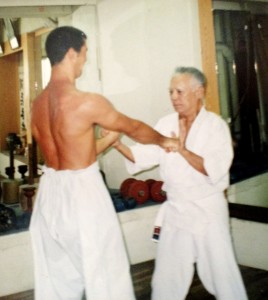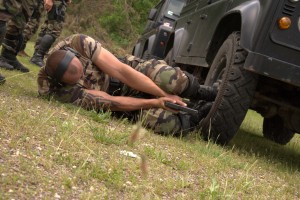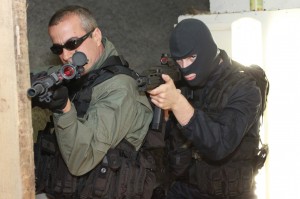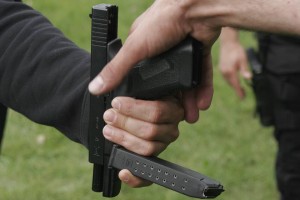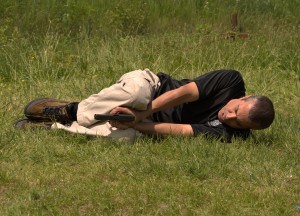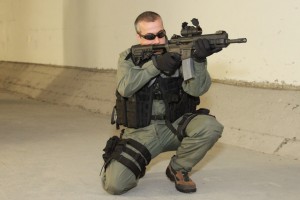“A knight in shining armor is a man who has never had his metal truly tested” ~ UNKNOWN
Copyright © 2014 Avi Nardia & Tim Boehlert
In a forthcoming DVD produced in conjunction with Budo Magazine, we’ll share ideas from traditional Martial Arts and CQB with modern day variations and techniques.
Teaching Martial Arts and Combatives, I often see ‘heroes.’ It’s said that after a war the marketplace is loaded with heroes and hero stories. Israelis at the age of 24 are writing autobiographical books about themselves. I’ve met many new Grand Masters. I’ve met men that after taking only a few days training with me, where they could hardly survive, are now Grand Masters! Students that I’ve kicked out of the Army and Police Academy are now the ‘real-deal’, accompanied now with their own war stories and life experiences. It all makes me wonder how the Israeli Martial Arts got watered down to the level that is prevalent today.
This new wave of Martial Artists and web-surfers run from one movie to the next movie fad, and they seem to only study the Martial Arts in waves and set their dreams and goals on a movie depiction of what some hollywood-type thinks is the latest/hottest Martial Arts and they fail to understand that it’s the man who makes the title and not the title that makes the man.
Close Quarters Battle (CQB) ideas are not new.
“To study the old is to understand the new.” —
Hanshi Patrick McCarthy
Suijutsu (水術 in Japanese) history tells us that fighting could take place anywhere, and that thereby a Samurai had to be ready to fight in every situation — immersed in the water of a river or the sea for example. In the old days a Bushido person had to study many arts from horsemanship to swimming and even writing and music and culture so as to be open minded and to have a broad viewpoint and to also have skills.
As a joke I always said that in Israeli Martial Arts we have also ‘Sue Do’: the art of suing! Around 2000 there were many lawsuits all over due to some dirty moves by a few greedy lawyers that had travelled to Israel for a few days, including sight-seeing, and when they got back they were experts in Israeli Martial Arts and they actually tried to trademark it. When I moved to the USA, I was one of the few to fight it. As a result of that, they attacked me in many forums, in any way they could including paying internet criminals to slander me by building an on-line blog that called me a fraud, citing that they were the real deal. None of them served in the Israeli Army an hour or even n the Israeli Police but somehow they miraculously knoew the real Israeli Martial Arts and sold certificates to teach it! It was really funny as the certificates were signed by Imi Lichtenfeld, who had passed away 15 years before, but he still managed to sign the certifications.
During that time I said I’d fight in court, or on the on-line forums, anywhere on the internet, in sea or air as that’s a part of my trust of what is CQB. You should able to fight in any field that you may find yourself in. I fought the slander and I never went down. It wasn’t and still isn’t right.
When we teach and study combatives remember: the point of Combative Martial Arts is aggressiveness, fearlessness and determination. The spirit of not giving up. And when I see different combative systems I can see no matter where and when they were ‘made’, they have a common lineage back to all of them. But this line is also brutality and we have to remember one more fact – age. And don’t forget injuries. Most combative arts are taught to kids between 18 to 22 who are in th best fitness of their lives! Any former soldier will admit that ‘yes, we were young and yes the body paid the price with injuries that we carry for a life-time.’ All admit that we must listen to the body and train smart.
I was invited to Wingate Sport University in Israel to lecture on the subject ‘slow is fast.’ I was paid by the Isaraeli government to explain the idea of how bones are on a continual growing process until we’re almost 22, and how all the stress on bones and joints can create damage for that will last us a life-time. How the muscles are faster to grow and adapt, but how the bones, joints and ligaments are slower to gorw and adapt and why we need to train slower to build a system. When asked why we get our young people into the Army in Israel at the age of 18, the answer is simple: they are too young to understand, easy to manipulate and direct. At an older age they would be smarter and maybe also refuse.
After seeing so many soldiers, police officers and special forces soldiers for so many years as a trainer I could see also different injuries. What does it mean to kill a person? “The weight of knowing that you’ve killed another person: is heavy. I’ve seen guys lose religion over it, and I’ve seen guys gain religion over it, through a course entitled ‘The Anatomy of a Kill.’ It was about what bullets do to people” he says. “How they tumble through the body, what kind of damage they do, the difference between soft organs and hard organs, what happens when the bullet hits what, how to deploy the round earlier so it pulls earlier and does more damage.” A friend asked me how do you train for it and how do you teach for it? It’s a hard issue. Do we talk to civilians or Army?
In my days I used to take my Counter-Terrorism Unit student to the hospital mortuary and show them bodies. The parts after bad accidents. I remember two friends that had been in suicide bombing situations and both said that each time they went in with the right mindset, they acted professional as a doctor or nurse would in the same situation, but that once they made a mistake and went in with the wrong attitude and mindset and lost it. So we can build, but that doesn’t mean that one day we won’t fail.
Combatives is a hard subject and this is why I like to keep teaching part of swordsmanship when I teach combatives as it’s the ultimate CQB using a sword in a mêlée. A mêlée is disorganized close-combat with a group of fighters. A mêlée happens when groups fight together in combat with no regard for group tactics or fighting as a unit. Each combative fights alone.
“Among many types of fighting encompassed by the general term ‘close combat’ includes the medieval and ancient mêlée and the modern terms hand-to-hand combat and close quarters combat (CQC.) Close combat occurs when opposing military forces engage in restricted areas, an environment frequently encountered in urban warfare. Military small unit tactics traditionally regarded as forms of close combat include fighting with hand-held or hand-thrown weapons such as swords, knives, axes, or tools. In modern times (since World War II), the term ‘close combat’ has also come to describe unarmed hand-to-hand combat, as well as combat involving firearms and other distance weapons when used at short range. William E. Fairbairn, who organized and led the famous Shangai Riot Squad of the Shanghai Municipal Police, devised a system of close-combat fighting for both soldiers and civilians which bears his name, ‘the Fairbairn System,’ incorporating use of the handgun, knife, and unarmed martial arts fighting techniques. Since that time, the term ‘close combat’ has also been used to describe a short-range physical confrontation between antagonists not involved in a military conflict, for example in riots and other violent conflicts between law enforcement personnel and civilians. Hand-to-hand combat, sometimes abbreviated as HTH or H2H, is a lethal or non-lethal physical confrontation between two or more persons at very short range (grappling distance) that does not involve the use of firearms or other distance weapons.
[1] While the phrase ‘hand-to-hand’ appears to refer to unarmed combat, the term is generic and may include use of striking weapons used at grappling distance such as knives, sticks, batons, or improvised weapons such as entrenching tools.
[2] While the term hand-to-hand combat originally referred principally to engagements by military personnel on the battlefield, it can also refer to any personal physical engagement by two or more combatants, including police officers and civilians.
[3] Combat within close quarters, to a range just beyond grappling distance, is commonly termed close combat or close-quarters combat. It may include lethal and non-lethal weapons and methods depending upon the restrictions imposed by civilian law, military rules of engagement, or ethical codes. Close combat using firearms or other distance weapons by military combatants at the tactical level is modernly referred to as close quarter battle. The U.S. Army uses the term combatives to describe various military fighting systems used in hand-to-hand combat training, systems which may incorporate eclectic techniques from several different martial arts and combat sports.Close Quarters Combat (CQC), Close Quarters Battle (CQB) or Close Combat Fighting is a physical confrontation between two or more combatants.
[4] It can take place between military units, police and criminals, and other similar actions. In warfare it usually consists of small units or teams engage the enemy with personal weapons at very short range, up to 30 meters, from proximity hand-to-hand combat to close quarter target negotiation with short range firearms. In the typical close quarters combat scenario, the attackers try a very fast, violent takeover of a vehicle or structure controlled by the defenders, who usually have no easy way to withdraw. Because enemies, hostages/civilians, and fellow operators can be closely intermingled, close quarters combat demands a rapid assault and a precise application of lethal force. The operators need great proficiency with their weapons, and the ability to make split-second decisions in order to minimize accidental casualties.Criminals sometimes use close quarters combat techniques, such as in an armed robbery or jailbreak, but most of the terminology comes from training used to prepare soldiers, police, and other authorities. Therefore, much material relating to close quarters combat is written from the perspective of the authorities who must break into the stronghold where the opposing force (OPFOR) has barricaded itself. Typical examples would be commando operations behind enemy lines and hostage rescues.Although there is considerable overlap, close quarters combat is not synonymous with urban warfare, now sometimes known by the military acronyms MOUT (military operations in urban terrain), FIBUA (fighting in built-up areas) or OBUA (Operations in Built Up Areas) in the West. Urban warfare is a much larger field, including logistics and the role of crew-served weapons like heavy machine guns, mortars, and mountedgrenade launchers, as well as artillery, armor, and air support. In close quarters combat, the emphasis is on small infantry units using light, compact weapons that one person can carry and use easily in tight spaces, such as carbines, submachine guns, shotguns, pistols, knives, and bayonets. As such, close quarters combat is a tactical concept that forms a part of the strategic concept of urban warfare, but not every instance of close quarters combat is necessarily urban warfare—for example, a jungle is potentially a stage for close quarters combat.
source: CQC Manuals
After teaching for many years I see how spirit and mind must be in place. Many times it’s more important than just the body conditioning in combative arts. The problem is in thinking about how to share it with students, mostly young and inexperienced, who may have their eyes on only the shiny armor and the brave knight, and also how to make them understand Zanshin and Kamae.
While talking with a friend from traditional Martial Arts I could see how Kendo explained it to me and that’s what I learnt best from Kendo, and now as a teacher. I was very surprised, but at the same time happy to hear and understand Kamae.
(心の構え) Kokoro no Kamae is the posture of your heart and mind. In Budo training you assume a posture so that you guard your weak points and make it difficult for an enemy to attack you; and at the same time, it is a strategy to expose the enemies weak points.
If you face an enemy without a kamae, you will be an easy target. Learning basic usage of kamae is among the first lessons beginners study. We physically adjust ourselves in certain ways in response to what the enemy shows us. We learn that from each kamae there are more favorable ways to move attack and defend and less favorable ways. You learn the strengths and the weaknesses of each posture and how to use them strategically against various types of attacks. You even see kamae in sports. Football and basketball for example use formations to respond to their opponents formations and have options to use based on their opponents adjustments. Kamae is also present in games like chess and of course in war in terms of battle formations.
Beyond physical kamae (just placing your arms legs and body in specific ways) there is mental kamae. If we look at he physical basics again, even there is present a mental aspect. You want to use your body in such ways as to lie to your enemy. This is basic Kyojitsu Tenkan 虚実転換… Kyojitsu Tenkan basically explained means that what the enemy can perceive and react to is not truly what your intention is. If it looks like your leg is open to an attack, it is not, if it looks like your arm can be grabbed, that is because you want them to grab it. Your true openings are hidden, and your true strengths are hidden as weaknesses. Many people never develop these skills, even at this level (and they miss most of the art by doing so) so it is not surprising that when it comes to mental and spiritual kamae not only do the vast majority never even think about it, they never train it nor gain skill with it.
Life is combat NOT sport!
Make your fighting stance your everyday stance.
– Miyamoto Musashi
“Beware the ego, it will be your downfall…”
Ritual Cat
When the spiritual teacher and his disciples began their evening meditation, the cat who lived in the monastery made such noise that it distracted them. So the teacher ordered that the cat be tied up during the evening practice. Years later, when the teacher died, the cat continued to be tied up during the meditation session. And when the cat eventually died, another cat was brought to the monastery and tied up. Centuries later, learned descendants of the spiritual teacher wrote scholarly treatises about the religious significance of tying up a cat for meditation practice.
source: traditional
A few days ago radical Muslims kidnapped three young Jewish kids and murdered them in cold blood. This act set about a new wave of hatred in Israel. Many Israelis demanded revenge. This is an ongoing story and was broadcast internationally – touching everyone. ‘An eye for an eye’ is the demand of many for revenge.If this is the way it will be the way, then we will soon be blind. This one act led to the attempted kidnapping of an eight year old by Jewish radicals, religious terrorists, that was at the last minute saved by his mother. SHe was able to thwart the kidnapping. The very next day these Jewish radcials managed to kidnap a 15 year old Muslim kid and burned him alive. What a shame, and how inhuman. The mother of one of the Jewish kids that had been murdered, Naftali Frenkel, R.I.P. said “there is no difference in blood to blood, or religion… a murder is a murder.” These words by a mournfing mother show that she is a warrior. Warriors do not lower themselves to the standards of other people; they live independently, according to their own standards and code of honor.
I find these words most important in these sad days in Israel as I see how low people can go. It makes me sad, and sick at the same time. Three terrorist’s kidnapping three kids and killing them simply because they are radical Muslims and the kids were Jewish. In Return six radical Jewish men kidnap a poor Palestinian Muslim child and brutally murder him in the most evil of ways — by burning him alive. These actions are not representative of Israelis and nor by the religious belief. These people are sick criminals and evil humans. These are not warriors, these are cowards. It’s a shame to even call them human. Terrorists are terrorists and war criminals, whether they be Muslim or Jewish or represent any religion. As responsible teachers, we must stop this crazy world from degrading further through education and by making warriors that will follow friendship love and peace.
Religion is not the problem, there are plenty of wars started by atheists (Hitler, Stalin et al). The problem is human nature. Unfortunately far too many people are just sheep who will blindly follow the dogma of whatever group they identify with. Whether it be Islamic fundamentalism or political correctness, the problem is still the same: group think, intolerance and the arrogance to believe that you are right and everyone who disagrees with you is wrong.
To hate is easy. This is why in traditional Martial Arts we teach our students to teach with Love and peace and tolerance and when we need to teach combatives, sometimes it’s just teaching how to hurt or how to kill, but we forget the manners and values. When you research the old Japanese military ways, they always followed Jutsu: Kenjutsu changed to Kendo Jujutsu to Judo from just art and skills to ‘The Way.’ The way of the modern era of teaching is from love and peace and tolerance, and not just skills. Today in MMA we face going backwards to just teaching skills and how to hurt and win, but not to make a very important point. Do we also teach in the right way and to the right people?
This made me leave the ‘family’ and build my own family that will follow those values and morals and here is the story of the ‘family’:
One day a man travelled deep into the jungle and met a monkey. He said hello to the monkey and was surprised when the monkey returned his greeting with “hello my friend!” The man didn’t know monkeys could speak, and so he asked the monkey to about this. The monkey said “yes we can speak, we just hide it.” The man then said “we humans say that monkeys and humans are of the same family.” The monkey was really happy to meet his ‘new’ relative and didn’t stop exclaiming “my family, my family!” Suddenly, out of nowhere a lion attacked both of them and the monkey pulled the man up into his tree and climbed high up to a safer place. The lion said “throw the human to me, and I will eat only him and I will set you free.” The monkey replied “no way, he is my family.” Through the long night the man eventually got tired of trying to out-wait the hungry lion below, and so he asked the monkey to watch over him as he slept and said that when the monkey would go to sleep and he would watch over him. While the man slept the lion asked the monkey again to let him eat the mand, and he’d let the monkey go free. But the monkey replied again “No. We are family.” When the man woke, he told the monky to sleep and stated that he’d keep watch over him. The Monkey went to sleep and the lion asked the man to “throw the monkey down to me to eat and I’ll set you free! The man didn’t think twice, and he threw the monkey down to the lion, but the monkey woke up quickly and before the lion could set his paws on him he jumped back into the tree and climb back up to where the man sat safely. This was really embarrassing to the man. Both knew what happened, but no one spoke of it. Then the lion fell asleep and the monkey said to the man “let’s go!” and he walked him safely all the way back to the edge of the jungle and said goodbye. As the man started walking, the monkey called him and said “can I ask you favor?” “Yes!” the man said, happy that the monkey still considered them friends depite what the man had tired to do to the monkey. The monkey said to him “would you please not mention to anyone that we are family?”
This brings me back to the Israeli Martial Arts, as I have been stabbed in the back by ‘friends’ and other greedy people that had been too ready to sell my friendship for almost no money and I decided to simply say “Please don’t mention that we’re family.” I have since buil my own family called WARRIOR, as warriors follow their heart and keep their values and morals! This is my family!
©Copyright, 2014 Maj. Avi Nardia & Tim Boehlert
Maj. Avi Nardia www.avinardia.com
Tim Boehlert www.defendublog.com

